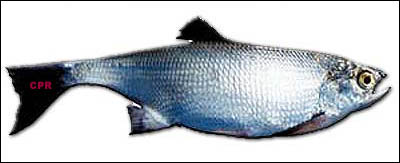Vol. 18 No. 3
March, 1988
|
Make Tomorrow Happen
|

Goldeye Lore
No
Ordinary
Fish Story
|

Dave Jones
|

The Winnipeg
Goldeye.
Part of the nostalgia for the
"good old days" of railroading is associated with the lure of the dining cars, with their shiny silver
cutlery, delicate rose bowls, patterned "Limoges" plates, lemon-water finger bowls, and
whitest of white linens.
The meals themselves were fairly standard fare, being somewhat restricted in their content by the limited storage,
refrigeration, and cooking space available in these rolling restaurants. However, there was the occasional exception
to this rule, and seasoned travellers soon learned what dishes to request.
One of these specialty items was Winnipeg Goldeye, a Prairie treat, served when available on the transcontinental
trains. Long a favorite with Canadian and American sportsmen, its reputation was well established with railway
travellers in the know.
The lore of the Goldeye has been traced back to the well-knownartist of the North American Indian, Paul
Kane, who made several references to the fish in his 19th century diaries.
"The Goldeye is a peculiar species of fish... like the herring, though larger, thicker, and not worth
catching", he commented, while reporting that his travelling companion had suggested that "they eat like
mud".
However, he was unaware of the hidden properties of the fish that could be brought out by smoking the catch over
willow wood; a procedure that was commonly practiced by the Cree Indians. The smoking imparted a
reddish-gold colour and a delicious taste that could only be achieved in this manner.
Before 1900, it was not uncommon to find Goldeye on the market for a cent a pound, or less, and its main commercial
uses were as dog food and fertilizer.
Fortunately, according to tradition, a Mr. Brandt, from Gimli, Manitoba, discovered the secret of the Cree Indians
in his backyard smokehouse, and the rest is culinary history.
The fame of the Goldeye spread throughout Canada and the U.S., but available supplies were always limited and it was
mostly consumed in the area around Winnipeg and, of course, on the transcontinental trains.
At first the entire catch came from Lake Winnipeg, but soon Lake Winnipegosis was yielding a fair amount of Goldeye,
and eventually the industry spread to Lake Manitoba, Red Lake, and The Pas in Manitoba, Lake Athabasca, the
Saskatchewan River, and even Lake Temiscaming in Quebec, although the quantities were small.
The peak years for Goldeye consumption were in the 1920s, with 1926 and 1929 having more than a million pounds
produced each year, but the yield tapered off after that. Rarely was there a sufficient supply for export, although
a few enterprising Americans managed to bring home their catch.
THE CANADIAN PACIFIC CONNECTION
Interestingly, there is a second connection between this storied fish and the Canadian Pacific, as the Royal
Alexandra Hotel was instrumental in bringing the Goldeye to the attention of the public.
Lucien Shickele, a former chef at the Royal Alexandra, recalls: "As I opened the Hotel Royal Alexandra in
1906, I made out my à la carte menus. Having done so, I met with the manager of the Winnipeg Fish Company to
find out what sort of different fish he had for the bill-of-fares. So he showed me, among other fish,
the Goldeye. And so I asked him then to smoke me some, which he did very satisfactorily; hence I called it the
smoked Winnipeg Goldeye, as then they were only obtainable from Lake Winnipeg".
Due to a shortage of willow for smoking large quantities of the fish, oak and maple were generally substituted with
the same fine results as to flavor, although the reddish colour was not achieved. A little red dye solved that
problem, however.
Chef Shickele attested to the growth in popularity of the Winnipeg Goldeye in a way that was certainly
understated: "I may say as time went on during my 34 years of service the demand for them increased",
he said.
And that's no fish story.
This CP Rail News article is copyright
1988 by the Canadian Pacific Railway and is reprinted here with
their permission. All photographs, logos, and trademarks are the property of the Canadian Pacific Railway
Company.
|